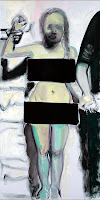
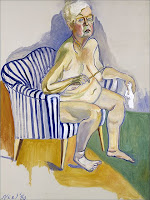
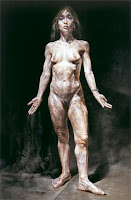
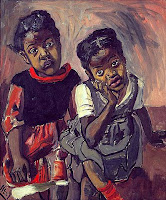
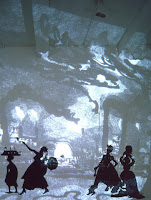
[Images from left: Woman of Algiers, Marlene Dumas; Unflinching Self Portrait, Alice Neel;Mea Corpa, Bailey Doogan; Two Girls, Spanish Harlem, Alice Neel; Installation at the Met, Kara Walker]
As a contemporary artist, it is imperative to question your place in art history. Although we may all wish to be off on our own doing something completely original, we are all affected by similar surroundings and, therefore, we may find kindred spirits with other artists. For a young artist, it is sometimes harder to do this because you compare yourself to those who have painted and lived so much longer than you.
For a very long time, figure painting has gone in and out of style. Even non-comformists still conform when they do not realize it. Some artists change with the times while others, like Alice Neel, spend a lifetime studying the figure; well, not the figure, the people. The artists whose work I have chosen are all, with the exception of Alice Neel, living idols of mine. Each has mastered the figure in their own way and does more than just "paints a nude."
Marlene Dumas, a Netharlands artist originally from Cape Town, is known for her large scale portraits of ghostly figures that emerge from a slew of well place brush strokes. Dumas' portraits captivate the viewer and make you question why she painted them in such a way (like unsettling, wall-sized portraits of babies.)
When you go to Alice Neel's website, you will find images of paintings that rage across almost 60 years. Living in New York, Neel spent most of her life painting the people around her, whether it was the yuppie gallery owner in the Village or the man at the bodega in Spanish Harlem, she painted her surroundings and captured the essence of the people in her paintings.
Another artist I look up to is Bailey Doogan. Something that I love about her work is that she says she does not paint the nude or the figure because those are art terms. In her artist statement she says that she paints "the mutable body where flesh moves, changes and has infinite variety." Doogan paints the flesh in its truest form. She embraces imperfections and takes special care to show them with her rich and realistic paintings.
Finally, Kara Walker is someone who I have admired for a long time. She is one of those "love me or hate me" artists. It seems like it would be difficult not to be when you tackle hot issues like the history of racism and sexism and how it is still prevalent today. Referencing the black silhouette paper cutouts from colonial times, Walker uses this traditional portrait technique to create entrancing installations. When the viewer walks into the gallery, they are amazed at the beautiful black on white and all of the care that went into cutting these figures. Then they notice what they are looking at, disturbing images of rape and killing. Walker has gotten a lot of criticism for her work, but I would be more worried if she didn't.
These are a few of the artists that I look to. They are my art heros. Everyone has them, so I urge you to find where you fit in art history.



.jpg)



